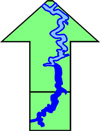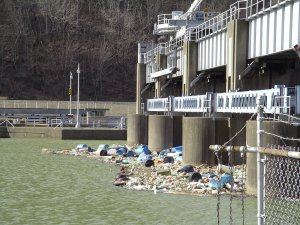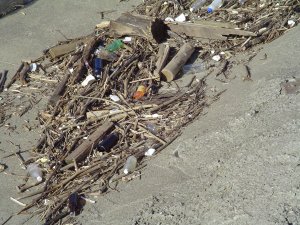
Upper Monongahela River Association
Menu
 Click
here for an 800 K version of this impage
Click
here for an 800 K version of this impage
Floating Trash
River trash and debris, consisting of man-made rubbish and naturally-occurring items such as wood wastes, deposits on river banks and at riverside facilities, and accumulates behind locks and dams. The US Army Corps of Engineers has no facilities for collection and disposal of this trash, so they periodically flush it downstream. It eventually sinks, rots, or ends up in the oceans.
Locally the trash creates many problems, including:
Visual and odor pollution;
Water pollution, hazardous to humans and aquatic life, from chemicals and hazardous materials in man-made rubbish;
Health and safety hazards, for community and industrial water intakes, swimmers, water skiers, marinas, public and private docks and launching ramps, and recreational boaters and river commerce;
Navigation hazards, for commercial and recreational boaters;
Interference with, and damage to, locks and dams.
The US Environmental Protection Agency has an on-line report pertinent to the floating trash and debris problem. It is Marine Debris Abatement at http://www.epa.gov/owow/oceans/debris/
The trash which accumulates behind the Morgantown Dam has been a public irritation for many years. As the development of trails, hotels, and other amenities along the river bank has accelerated, so has a public sense of outrage. UMRA is joining with local groups to search for a solution to this problem.
For several years Tim Terman has run a trash removal effort using kayaks and a pontoon boat with volunteers ranging from children to adults. Tim was selected as one of the Dominion Post 's100 Most Influential Citizens in 2008 in recognition of his efforts. Tim has proposed installing a trash boom at the Hildebrand Dam to reduce the amopunt of trash reaching Morgantown. You can read his proposal.
Dams are not all alike, even on the navigable portions of the rivers of the Pittsburgh District. The water flows under our dam. This is why floating trash accumulates so readily behind it. On many dams, water flow is over the dam, and most floating material passes without major impediment.
It is not unfair to say "the Corps created our trash problem" as a part of solving other river problems. Of course, in the 1950s there were few plastic products and many containers were returned for refilling. The current problem was not foreseen.
Community Concern about Floating Trash
Resolution on Floating Trash by the City of Morgantown
Resolution on Floating Trash by the City of Westover
Resolution on Floating Trash by the Town of Star City
Resolution on Floating Trash by the Monongalia County Development Authority
Resolution on Floating Trash by the Monongalia County Commission
A Sample Resolution on Floating Trash
Meeting - Monongalia County Solid Waste Authority - 20 November 2003
News about Floating trash
Port of Houston Receives Award from AAPA for Floating Trash Skimming Program - United Marine International PRESS RELEASE - 14 May 2004
Letter To Editor - Dam Trash: Let's Clean Up the Mon River Soon - Morgantown Dominion Post - 13 May 2004
Commissioners Try to Slow Spread of Trash: Anti-Littering Signs are one Proposed Solution to Persistent Problem Along Mon River - Morgantown Dominion Post - 29 April 2004
Meeting Weighs Anchor on Trash: Mixed Results Emerge from Session on Debris in River and Behind Dam - Editorial Morgantown Dominion Post - 29 April 2004
Meeting Focuses on River Trash - Morgantown Dominion Post - 26 April 2004
Area Officials Continue to Talk Trash - Morgantown Dominion Post - 22 April 2004
Kids Discuss Trash with Mayor - Morgantown Dominion Post - April 7, 2004
Trash Talk Continues in Commission - Morgantown Dominion Post - April 8, 2004
Letter To Editor - Local Resident Tired Of Garbage Along River - Morgantown Dominion Post - April 12, 2004
All Dams on River Are Not Equal: Design of Local Facility Causes Part of the Built Up Debris Field - Morgabtown Dominion Post - March 27, 2004
That Dam Trash: Pileup of Debris in the Monongahela an Eyesore - Morgantown Dominion Post - March 23, 2004
Debris Threatens Recreation Site - The Charleston Gazette - January 24, 2004
Officials Hope for River Debris Solution - Morgantown Dominion Post - November 10, 2003
Monongalia Officials Seek Federal Help to Remove Debris Behind Locks - The Charleston Gazette - November 10, 2003
Morgantown Council Looks For River Trash Resolution - Morgantown Dominion Post - November 4, 2003
County Joins In River Cleanup - Signs Onto Resolution - Morgantown Dominion Post - October 16, 2003
County Buys New Recycling Baler: Resolves To Clean Trash Behind Locks - Morgantown Dominion Post - October 10, 2003
Development Authority Considers Cleanup Of Lock-And-Dam Trash - Morgantown Dominion Post - October 9, 2003
Our Search for a Solution
 Click here for an 800 K version of this impage
Click here for an 800 K version of this impage
The Nature of the Trash
There is little hard data on the trash involved, but we know that it has the following characteristics:
Material such as leaves, branches, and trees ends up in the river as a result of natural processes. From an environmental perspective, this material is part of the food chain for river life. Although large logs may be a hazard to navigation, they provide important fish habitat.
Organic material from timber and landscaping operations, and construction debris, also finds its way into the river. It is unclear whether this constitutes an additional resource or a problem.
Much of the most visible trash consists of light plastic items such as bottles, balls, and styrofoam. We do not know how much of this is the result of intentional dumping (point sources), and how much results from simple littering and wind and flood dispersal of materials (non-point sources.)
Large containers like barrels may be escaped dock flotation, wind and flood dispersed material, or possibly intentional disposal of hazardous wastes. *
We have suggested that an initial phase of a search for a solution should include a study of trash characteristics, possibly based on video surveillance at the dams. A video surveillance program might make be included in a system which also serves other security needs.
* Barrels are an interesting sub-category. Most are empty and benign. Because they are potentially very hazardous, the US Coast Guard instructs its Auxiliary patrols not to touch them, but to inform relevant local authorities of their presence. In most areas such local authorities do not have the training or equipment required to deal with them.
Novel Boats That Remove Trash And Debris From Waterways
There are boats designed to remove floating trash and debris. As far as we can tell, none of these has been used in turbulent waters typical of those near our navigation locks. Our preliminary estimate is that such a bout would involve an initial investment of a quarter to half a million dollars in the boat and support facilities, and an operating cost of about a hundred thousand dollars a year.
Check out these websites:
Trash Cat at http://www.trashskimmer.com
Trash Hunter at http://www.aquarius-systems.com
Liverpool Water Witch at http://www.waterwitch.com
Hydro-Skimmer at http://www.alphaboats.com
Corps of Engineers Huntington District Debris Control Efforts
The U.S. Army Corps of Engineers Huntington District has been a leader in the study of the trash problem. We have recently received a copy of the Bluestone Drift and Debris Evaluation Study published in December 1996. It includes about 200 pages, which we are still reviewing. Bluestone Lake is of economic concern because a high precentage of West Virginia's whitewater rafting business is conducted on the waters down stream.
Congress directed the Secretary of Defense "to take such measures as are technologically feasible to prohibit the release of drift and debris into waters downstream of the project, except for that organic matter necessary to maintain and enhance the biological resources of such waters and such nonobtrusive items of debris as may not be economically feasibile to prevent being released through such project, including measures to prevent the accumulation of drift and debris at the project, the collection and removal of drift and debris on the segment of the New River upstream of the project, and the removal (through use of temporary or permanent systems) and disposal of accumulated drift and debris at Bluestone Dam. "
This evaluation study addresses the potential for modification of the Bluestone Lake project. For the purposes of the report, drift is defined as natural, woody material, and debris is defined as man-made refuse. Both can be found floating down the New River, most notably during flood events. The legislation concerns the handling of this drift and debris at the Bluestone project and the development of technologically feasible measures to address the problems associated with drift and debris management at the project. An initial review conducted as a part of this study has found that the primary source of the drift and debris management problems at Bluestone are due to a change of operating pool levels during project construction 52 years ago and the continuing placement of solid waste within the floodway of streams by residents of the region. The interim drift and debris management technique adopted for the Bluestone project 52 years ago has proved to be a long-term operating plan, but it is no longer acceptable because of changed perceptions and conditions in the region.
The project includes a multi-level intake tower and tunnel to permit drift and debris to pass as it reaches the dam, rather than the current operating procedure of releasing accumulated drift and debris at summer pool. Low flows at summer pool cause drift and debris to accumulate just downstream of the dam and in some areas of the New River Gorge National River, particularly above Sandstone Falls. The structural modifications will facilitate downstream material progression during higher flows. Scheduled for completion in January 2004, the intake tower and tunnel will allow drift and debris passage to mimic a more-natural condition.
Improved Operating Equipment: The improved equipment includes a new motorized barge with a crane to allow continuous removal of bulky and/or obtrusive man-made debris. The new barge would be fitted with attachments for cutting logs and pushing floating material to the multi-level release tower. a Jon boat with motor and trailer to assist with debris removal and transfer. A 5-ton dump truck to transport solid waste collected from the lake's surface.
The National Park Service (NPS), and the West Virginia Department of Environmental Protection (WVDEP) are working with the Corps on a Public Awareness Program and a downstream cleanup component
The downstream cleanup component includes two stages. In the first stage, partnering with WVDEP, the Corps would address existing deposition along a 55-mile reach of the New River from Bluestone Dam to Hawk's Nest State Park. The work includes manual efforts to pick up man-made debris, water transportation to access points, loading debris onto trucks, transport, and appropriate disposal.
Stage Two is a periodic downstream cleanup. WVDEP and NPS would be responsible for this effort. WVDEP and NPS participation in stage two is funding dependent, and not considered a requirement for commitment of Federal funds for stage one. The periodic cleanup is merely a plan component which WVDEP and NPS will continue to implement, and not a post-project operation and maintenance requirement. Corps participation will be reflected through increased efforts to remove man-made debris from the lake surface during periods of inflow.
UMRA notes that this is a very expensive operation, and we understand that underfunding of Corps and NPS budgets, along with WV funding issues, is drastically hampering efforts in 2004.